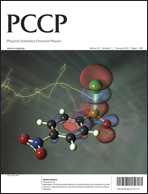Insights of the Peroxychloroformyl Radical ClC(O)OO via Microwave Spectrum
IF 2.9
3区 化学
Q3 CHEMISTRY, PHYSICAL
引用次数: 0
Abstract
The exploration of Venus has received much attention in the past and will keep growing due to the starting of the NASA DAVINCI project. To explain the extremely low O2:CO ratio observed in Venus’ atmosphere, a chlorine-initiated CO oxidation catalytic cycle has been proposed. However, relevant studies on the key intermediates, such as the peroxychloroformyl radical (ClC(O)OO), are rare. In this study, the ClC(O)OO radical was observed using Fourier-Transform Microwave (FTMW) spectroscopy under the supersonic expansion condition. Two conformers, trans-ClC(O)OO and cis-ClC(O)OO, and their chlorine isotopologues were detected. The molecular constants including the fine and hyperfine constants, were determined. Based on the experimental and the ab initio calculations, the unpaired electron is mostly located at the terminal oxygen atom, supported by the small magnetic hyperfine constants of chlorine. In addition, the angles between the Cl–C bond and the a-axis of the trans-35ClC(O)OO and trans-37ClC(O)OO are similar, but these angles are different for cis-ClC(O)OO, making the quadrupole coupling tensors in the inertial axes disagree with the ratio of the quadrupole moments of 35Cl and 37Cl. Finally, we concluded that the ClC(O)OO radicals should behave similarly to other peroxyl radicals, as assumed in the current photochemical model of Venus.求助全文
约1分钟内获得全文
求助全文
来源期刊

Physical Chemistry Chemical Physics
化学-物理:原子、分子和化学物理
CiteScore
5.50
自引率
9.10%
发文量
2675
审稿时长
2.0 months
期刊介绍:
Physical Chemistry Chemical Physics (PCCP) is an international journal co-owned by 19 physical chemistry and physics societies from around the world. This journal publishes original, cutting-edge research in physical chemistry, chemical physics and biophysical chemistry. To be suitable for publication in PCCP, articles must include significant innovation and/or insight into physical chemistry; this is the most important criterion that reviewers and Editors will judge against when evaluating submissions.
The journal has a broad scope and welcomes contributions spanning experiment, theory, computation and data science. Topical coverage includes spectroscopy, dynamics, kinetics, statistical mechanics, thermodynamics, electrochemistry, catalysis, surface science, quantum mechanics, quantum computing and machine learning. Interdisciplinary research areas such as polymers and soft matter, materials, nanoscience, energy, surfaces/interfaces, and biophysical chemistry are welcomed if they demonstrate significant innovation and/or insight into physical chemistry. Joined experimental/theoretical studies are particularly appreciated when complementary and based on up-to-date approaches.
 求助内容:
求助内容: 应助结果提醒方式:
应助结果提醒方式:


